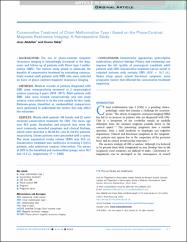| dc.contributor.author | Abdallah, Anas | |
| dc.contributor.author | Rakip, Usame | |
| dc.date.accessioned | 2022-05-16T13:54:05Z | |
| dc.date.available | 2022-05-16T13:54:05Z | |
| dc.date.issued | 2022 | en_US |
| dc.identifier.citation | Abdallah, A., & Rakip, U. (2022). Conservative Treatment of Chiari Malformation Type I Based on the Phase-Contrast Magnetic Resonance Imaging: A Retrospective Study. World Neurosurgery. | en_US |
| dc.identifier.issn | 1878-8769 | |
| dc.identifier.uri | https://doi.org/10.1016/j.wneu.2022.03.126 | |
| dc.identifier.uri | https://hdl.handle.net/20.500.12933/1021 | |
| dc.description.abstract | Background
The use of phase-contrast magnetic resonance imaging is interestingly increased in the diagnosis and follow up of patients with Chiari type I malformation (CM1). The current study aimed to elaborate the benefits of conservative treatment by evaluating consecutively treated adult patients with CM1 who were selected on basis of phase-contrast magnetic resonance imaging.
Methods
Medical records of patients diagnosed with CM1 were retrospectively reviewed at 2 neurosurgical centers spanning 8 years (2010–2017). Adult patients with CM1, who were treated conservatively and met study criteria, were selected to be the core sample for this study. Between-group (benefited vs. nonbenefited) comparisons were performed to understand the factors that may affect the outcomes.
Results
Ninety adult patients (68 female and 22 male) received conservative treatment for CM1. The mean age was 40.6 years. Headaches and pinprick loss were the most commonly recorded symptoms and clinical findings, which were recorded in 58 (64.4%) and 31 (34.4%) patients, respectively. Eleven patients were presented with a syrinx. The mean aqueductal stroke volume (ASV) was 16.5 μL. Conservative treatment was ineffective in treating 5 (5.6%) patients, who underwent surgical intervention. The means of ASV in the benefited and nonbenefited groups were 16.7 and 13.2 μL, respectively (P = 0.004).
Conclusions
Conservative approaches (prescriptive medications, physical therapy, Pilates, and swimming) can improve the life quality of nonsurgical candidate adult patients with CM1. Conservative treatment can be useful in selected patients with variably CM1 (ASV = 16.7 μL). Heavy sleep apnea or/and functional symptoms were prognostic factors that affected the conservative treatment negatively. | en_US |
| dc.language.iso | eng | en_US |
| dc.publisher | Elsevier | en_US |
| dc.relation.isversionof | 10.1016/j.wneu.2022.03.126 | en_US |
| dc.rights | info:eu-repo/semantics/embargoedAccess | en_US |
| dc.subject | Chiari malformation type I | en_US |
| dc.subject | Conservative treatment | en_US |
| dc.subject | CSF flow MRI | en_US |
| dc.subject | Phase-contrast MRI | en_US |
| dc.subject | Prognosis | en_US |
| dc.subject | Prognostic factor | en_US |
| dc.title | Conservative Treatment of Chiari Malformation Type I Based on the Phase-Contrast Magnetic Resonance Imaging: A Retrospective Study | en_US |
| dc.type | article | en_US |
| dc.authorid | 0000-0001-7494-0335 | en_US |
| dc.department | AFSÜ, Tıp Fakültesi, Cerrahi Tıp Bilimleri Bölümü, Beyin ve Sinir Cerrahisi Ana Bilim Dalı | en_US |
| dc.contributor.institutionauthor | Rakip, Usame | |
| dc.identifier.startpage | 1 | en_US |
| dc.identifier.endpage | 12 | en_US |
| dc.relation.journal | World Neurosurgery | en_US |
| dc.relation.publicationcategory | Makale - Uluslararası Hakemli Dergi - Kurum Öğretim Elemanı | en_US |
















